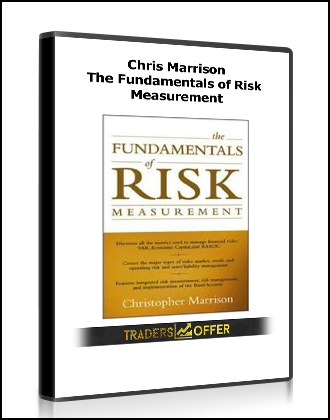The Fundamentals of Risk Measurement by Chris Marrison
$25.00

The Fundamentals of Risk Measurement by Chris Marrison
Get The Fundamentals of Risk Measurement by Chris Marrison at Salaedu.com
The Fundamentals of Risk Measurement introduces the state-of-the-art tools and practices necessary for planning, executing, and maintaining risk management in today’s volatile financial environment. This comprehensive book provides description and analysis of topics including:
- Economic capital
- Risk adjusted return on capital (RAROC)
- Shareholder Value Added (SVA)
- Value at Risk (VaR)
- Asset/liability management (ALM)
- Credit risk for a single facility
- Credit risk for portfolios
- Operating risk
- Inter-risk diversification
- The Basel Committee Capital Accords
The banking world is driven by risk. The Fundamentals of Risk Measurement shows you how to quantify that risk, outlining an integrated framework for risk measurement and management that is straightforward, practical for implementation, and based on the realities of today’s tumultuous global marketplace.
“Banks make money in one of two ways: providing services to customers and taking risks. In this book, we address the business of making money by taking risk.…”―From the Introduction
In The Fundamentals of Risk Measurement, financial industry veteran Chris Marrison examines what banks must do to succeed in the business of making money by taking risk. Encompassing the three primary areas of banking risk―market, credit, and operational―and doing so in a uniquely intuitive, step-by-step format, Marrison provides hands-on details on the primary tools for financial risk measurement and management, including:
- Plain-English evaluation of specific risk measurement tools and techniques
- Use of Value at Risk (VaR) for assessment of market risk for trading operations
- Asset/liability management (ALM) techniques, transfer pricing, and managing market and liquidity risk
- The many available methods for analyzing portfolios of credit risks
- Using RAROC to compare the risk-adjusted profitability of businesses and price transactions
In addition, woven throughout The Fundamentals of Risk Measurement are principles underlying the regulatory capital requirements of the Basel Committee on Banking Supervision, and what banks must do to understand and implement them. The requirements are defined, implications of the New Capital Accord are presented, and the major steps that a bank must take to implement the New Accord are discussed. The resulting thumbnail sketch of the Basel Committee, and specifically the New Capital Accord, is valuable as both a ready reference and a foundation for further study of this important initiative.
Risk is unavoidable in the financial industry. It can, however, be measured and managed to provide the greatest risk-adjusted return, and limit the negative impacts of risk to a bank’s shareholders as well as potential borrowers and lenders. The Fundamentals of Risk Management provides risk managers with an approach to risk-taking that is both informed and prudent, one that shows operations managers how to control risk exposures as it allows decision-making executives to direct resources to opportunities that are expected to create maximum return with minimum risk. The result is today’s most complete introduction to the business of risk, and a valuable reference for anyone from the floor trader to the officer in charge of overseeing the entire risk management operation.
Get The Fundamentals of Risk Measurement by Chris Marrison at Salaedu.com
1 review for The Fundamentals of Risk Measurement by Chris Marrison
Add a review Cancel reply
Related products
Forex - Trading & Investment
Forex - Trading & Investment
Forex - Trading & Investment
Pristine – Oliver Velez – Core, Swing, Guerrilla, Momentum Trading, Micro Trading Tactics
Forex - Trading & Investment
Michael Parsons – Channel Surfing Video Course (Manual,Video)










Trevis Trevis –
We create this shop with the mission: Bring the courses to 500 millions of people in the world, to help them awake their power and change their